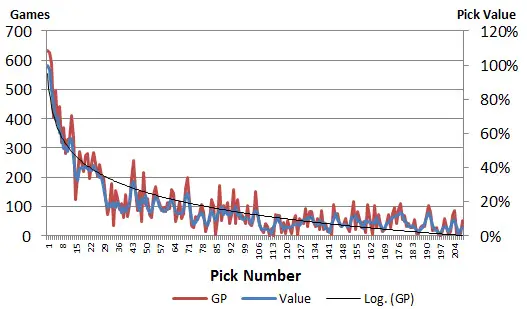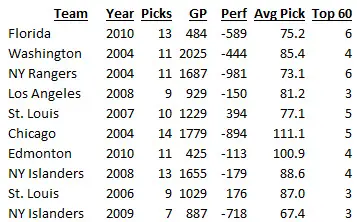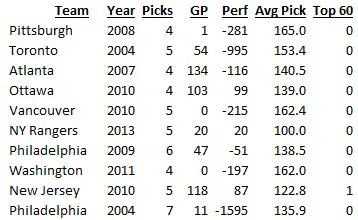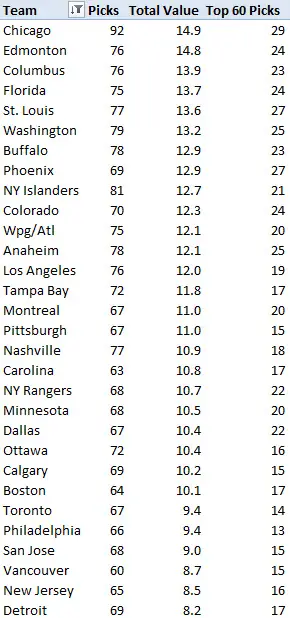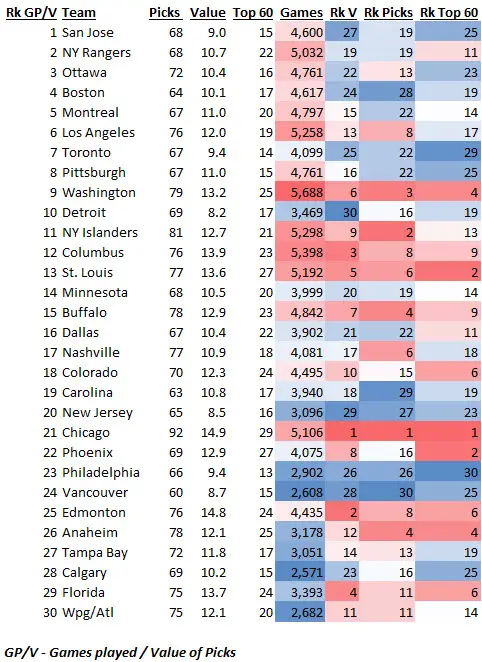Measuring the draft by games played was an interesting start (part one), trying to find sense in it by comparing those games played lost to number of picks, average of picks, and number of top 60 picks (part two) was an attempt to find order in chaos.
But what if you compare data based on the value of each draft pick, essentially the deepest dive you can do in order to analyze draft performance of games played versus draft selections over a ten year span.
I’ve seen attempts to value draft picks before so I’m not inventing the wheel, in fact I really wish I had beat them to it. For this exercise I recreated a similar analysis using games played so I could value each pick in order to get a more comprehensive look at what teams have going for them before you look at the summary table of games played lost over a ten year period.
Basically you take the average of games played, this time I used a 20 year time period for 7 rounds, and then rank every pick in average games played over the 20 years. Then you take the first overall pick which luckily had the most games played on average as 1.0, and every other value as percentage of 1.0 and let the curve form. The result isn’t uniform but it does show the trend which is …
1. a steep decline from high value to moderate value in the first round followed by …
2. a slower decline from a low starting point in the second round to a …
3. very flat curve that goes out over the life of the remaining 5 rounds.
Anyone can hit a home run with any pick, but on average you need a high pick in the first round to guarantee success, and things fall off quickly after that.
With this analysis you can get a pretty good indication of how picks stack up if you want to move up in the draft, or at least if both sides of the transaction have done a similar analysis.
Trading Up:
Using a Flame’s example, lets say the Flames wanted to move up to the third spot and draft Noah Hanafin. In my study the first overall pick is worth 1.0 or 100%, the second .97 and the third pick is worth .85. Calgary would need to give Arizona more than .85 in pick value in order to make it worth their while to reliquish that third overall pick (leaving aside of course, that players could be included as well). To get to say .87 and make the deal the Flames would have to give up …
their first round pick, .40
plus their own 2nd round pick, .25
plus one of their other 2nd round picks, .17
plus something in the neighborhood of a 5th round pick, .07
Or mathematically; .40 + .25 + .17 + .07 = .89 and the Coyotes either bite or not. Quite a package, for sure, but likely no where near what they’d actually have to pay in order to move up, suggesting it’s likely wise not to do so.
Trading Down:
Therefore maybe the more astute move is to move down, that is if the market overpays to move up in recent drafts.
You give up the higher quality pick, but you accrue more draft value and with that, all other things being held equal you should do better at team building.
For interest though let’s assume the Flames move down from 15 to 21 because they like 7 players equally and want to monetize the value of the 15th pick and garner extra assets.
I grouped the draft into bands to take some of the noise out and if you go by bands the value of the two picks is almost exactly the same. The 14-15 range is worth .405 and the 21-25 band is worth .390, meaning only .015 of differential or a 7th round pick as a difference. If you look at picks #15 and #21 individually and take the noise it’s ironically the Flames would have to thrown in an extra pick as the 15th pick has underperformed traditionally over the years compared to say picks 14 and 16.
NHL general managers clearly tend to pay too much to move up historically, at any rate.
Draft Year Value
An interesting off shoot out of valuing each pick is the fact that you can value each draft year. The Flames will add picks, trade picks, move up, move down, but in the end they will select between say five and nine players each draft year using picks that are assigned value. When you sum these values up you get an idea of what strength each draft year should have had for each team, and make comparisons to how the teams actually fared.
First the base cases …
In the last piece we looked at the average pick in a draft if a team drafts first in every round, 15th in every round, and 30th in every round. This can be done for pick values as well.
1st – picking first overall gives the top team 1.66 in draft value over 7 picks
15th – picking 15th every round gives a team 1.06 in draft value over 7 picks
30th – picking 30th in every round gives a team 0.79 in draft value over 7 picks
These summaries provide a great measured differential between the three points as well, as drafting first gives that club a 56% higher value in the draft then drafting 15th, and 110% more value than drafting last, but at least that team won the cup!
Over the ten year span we are looking at some teams have really gone out of their way to add value at the draft, below are the top ten highest draft pick value accumulators in this time frame.
Some pretty heady numbers in there when you see Florida and Chicago with 13 and 14 picks in the draft going the quantity route, or in contrast the Islanders of 2009 that had only 7 picks, but in those 7 were the first and 12th overall. How did they do? Well Florida added Gudbranson and Bjugstad, Chicago found Barker, Bolland, Bickell and Brouwer, boosting their organization. The Capitals were effective in 2004 adding Ovechkin, Schultz and Green and some spare parts. The Islanders altered their future in their two high value drafts by adding Tavares, De Haan and Cizikas in 2009, after bolstering their squad with Bailey, Hamonic, Matt Martin, and Jared Spurgeon.
More is well … more.
On the flipside you have teams that shed draft picks like recycled paper every year, below is the list of the top ten least value drafts in this time period.
The thing that really stands out in this table is the final column; look at the number of top 60 picks these teams have, they essentially cleared house, leaving the 3rd through 7th rounds to do their picking. Pittsburgh and the Rangers in 2013 make sense, as both clubs were in win now mode, but was Atlanta and Toronto thinking?
Either way you had better be giving up picks for value in these cases, because look at the total games played from these drafts? Three of the top ten are essentially zero games found, others are double digits, and the Rangers are still too soon to be judged.
So keep those picks at any cost? Well lets take a look.
The Draft Champs
The long and winding road through three days and almost 5,500 words of Calgarypuck content has finally reached at least what I would call a conclusion. Along the path I’ve learned that my old Hossa Rule was too fierce and an unfair way to measure draft talent by organization, which was a lucky thing given the Flames finished dead last in lost games played.
Sadly they won’t fare much better below with my ten year draft rankings.
Above we’ve established value in draft picks. This value is important to keep, and expensive to acquire. There are teams that have made a point of building up this value for every draft, others that have given it away like water a school fountain.
To start the true draft rankings lets look at value habits by organization.
Way up at the top you see the Blackhawks who under Stan Bowman (Assistant GM, then GM in this time period) clearly put a onus on acquiring draft picks, and moving up in the draft. They top the charts in total draft picks, total top 60 draft picks and total accrued draft pick value at 14.9 (1.49 per season in comparison to the 1st pick benchmark of 1.60). You may have noticed they’ve done quite well on the ice.
The next three teams are an example of building draft value through terrible on ice results as the Oilers, Jackets and Panthers have all had high picks in the first two rounds to build up their draft pick value totals. The Oilers for example finished second in value despite having 16 less picks (5 less top 60 picks) in the 10 year life span.
At the bottom of the pile you have the Detroit Red Wings who have made the playoffs each of the past 26 seasons, and with it accruing very little in draft pick value.
But who has made the most of the value or their investment? Picks are expensive to acquire, and valuable assets to move. Regardless of strategy, games played by draft picks divided by the value of the draft picks themselves is an excellent way to cut through the data and crown the true draft champions. A team that finds moderate games played with very low draft pick value likely picked up players and assets by dropping their pick value and should be applauded. Conversely, teams that have moved assets to build their draft value and with it selected 1000’s of games played have done an excellent job of being aggressive in the draft.
Draft Champs: The San Jose Sharks
The Sharks have done more with less than any organization in hockey. They rank 27th in pick value, 19th in total picks, and 25th in picks in the top 60 but still finished in the upper half of the clubs with 4,600 games played. Bang for buck the Sharks have managed their draft assets more effectively than any other team. Key players in this time frame would include Vlasic, Setoguchi (yep), Couture, Bonino, Demers, Wingels, Charlie Coyle, Nieto and Hertl, as the Sharks have kept their cupboards stocked.
The Rangers are one of only 6 teams to draft over 5,000 games played in these ten years, and they did it with the 19th highest draft pick value and number of picks. The Senators, Bruins and Canadiens around out the top five.
How about the teams that did the poorest in managing their draft pick asset pool?
Draft Dolts: Winnipeg / Atlanta
First off this is 90% an Atlanta and Don Waddell issue and not a Winnipeg Jet phenomenon, but the franchise itself is dead last in games played per value accrued finding only 2,682 games played despite having the 11th highest draft value, the 11th most number of picks, and the 14th most top 60 picks. The Thrashers busted their first round pick in 2004 and 2005 despite having the 10th and 16th picks in those drafts, and even the picks they got right (Kane and Bogosian) have moved on to other pastures.
The other four teams rounding out the fumbling five? Florida, Calgary, Tampa Bay and Anaheim. So the Flames move out of the 30th spot in games played lost, but certainly haven’t made themselves into draft stars in this process.
Chicago finished 21st in asset usage, but did acquire 5,106 games for their efforts.
The Capitals were the best example of spending for value and finding a good outcome as they finished 9th in asset usage and 1st in games played. They had the 6th highest draft pick value, so at least there is an example of an aggressive team finding success.
At the end of the day draft picks, just like cigarettes in prison are currency. You have to manage your draft assets well in order to succeed in building a hockey team in the modern NHL. The salary cap has made wiggling out of mistakes more difficult and spending money to fill holes all but extinct as July 1st has become a day of filler with the draft the principal team building event of the calendar.
Teams need to respect the value of their picks, have a strategy to either monetize the pick value for players or moving down, or acquire additional picks and select the right players. If not they will always wallow at the bottom of the standings.
Join us tomorrow for a deeper dive on the Flames themselves





